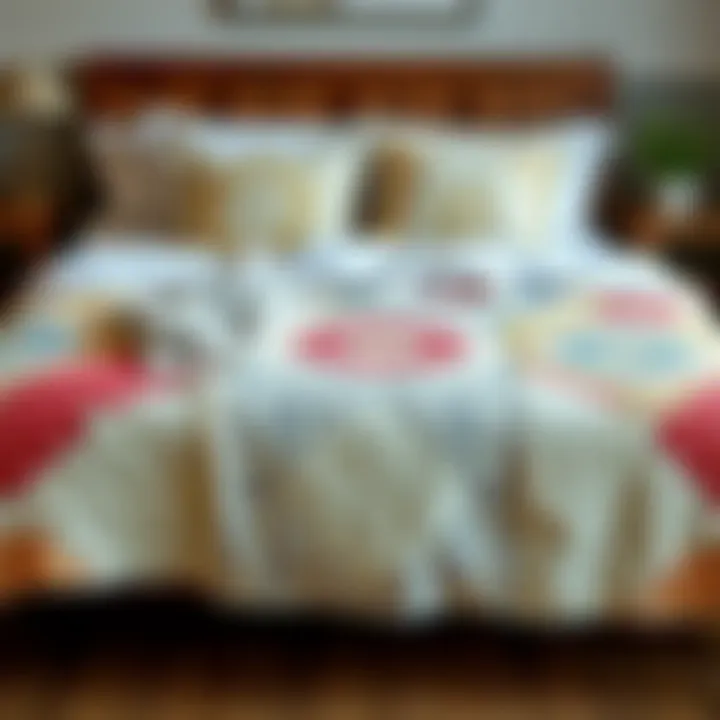Mastering Bed-Making: Quilts and Duvets Explained


Intro
Creating a beautiful bed may seem simple, but there's a subtle artistry to the task that can transform your space from average to extraordinary. Mastering the use of quilts and duvets not only enhances the aesthetics of your bedroom but also contributes to comfort. This guide aims to dissect the intricate steps and styles involved in making a bed that feels inviting and looks polished, so let's jump into the world of vibrant patterns and cozy layers that give our spaces a touch of personality.
Design Inspirations
Making a bed isn’t just about functionality; it’s also about expressing your style. Here are some ways to draw inspiration for your next layering adventure.
Trending Styles
First up, let’s chat about trends in bed-making. Currently, there’s a significant shift towards minimalist designs with clean lines and muted colors. Think Scandinavian simplicity where the focus is on texture and natural materials. At the other end of the spectrum, eclectic spaces are thriving too—layering colorful quilts over stylish duvets or mixing different patterns for a vibrant look.
Some other noteworthy styles include:
- Bohemian: Overflowing prints and textures create a relaxed, lived-in feel.
- Modern Farmhouse: Emphasizing white or neutral shades with rustic accents that invoke warmth and charm.
- Tropical: Embrace bold colors and botanical patterns, perfect for adding a splash of life and energy.
Color Palettes
When it comes to color, choosing a palette can make all the difference. Soft pastels are making waves, adding a calming effect ideal for a peaceful night's sleep. Alternatively, bright pops of color can invigorate a room, making it come alive. Here are some color palettes to consider:
- Soft Neutrals: Ivory, beige, and light gray for a serene atmosphere.
- Earthy Tones: Olive greens, burnt oranges, and muted browns create a warm, inviting vibe.
- Bold Contrasts: Deep blues or rich reds paired with crisp white can add a dramatic flair.
A well-made bed isn’t just for show; it's a haven for relaxation and rejuvenation.
Maintenance and Upkeep
Once you've mastered the art of bed-making, maintaining that fresh, polished look is key. Here are some handy tips to keep your bedding in top shape.
Seasonal Maintenance Checklist
Changing seasons often require adjustments to your bedding. Here’s a simple checklist to follow:
- Spring:
- Summer:
- Fall:
- Winter:
- Wash quilts and duvets to remove winter dust.
- Rotate or flip your mattress for even wear.
- Switch heavier quilts for lighter materials like cotton or linen.
- Freshen up with breathable fabrics to keep cool.
- Layer with heavier textiles and cozy throws for warmth.
- Inspect for wear and tear before the colder months.
- Add additional layers with thicker duvets or blankets for insulation.
- Regularly fluff your bedding to maintain its shape.
Cleaning and Organization Tips
Keeping your bed looking sharp does not just mean making it. Cleaning plays a massive role:
- Wash duvet covers and quilt covers regularly to keep them smelling fresh.
- Use duvet clips to prevent shifting within covers.
- Store off-season bedding in breathable bags to keep dust at bay and save space.
By weaving together styles, colors, and maintenance tricks, a bed can become much more than a place to sleep; it can tell a story, elevate the ambiance of a room, and offer unapologetic comfort. Incorporate your unique taste and let your bedding reflect your personality, making every bed-making session a delightful experience.
Understanding Bedding Essentials
When diving into the realm of bedding, it’s like stepping into a world where style meets comfort. You see, understanding the basics of bedding essentials is crucial, not just for aesthetics but for a good night’s sleep. We want our beds to be welcoming; after all, it’s where we recharge for the next day ahead. The marriage of function and design serves as the foundation of a well-made bed, setting the stage for personal expressions through quilts and duvets.
The Role of Quilts in Bed Design
Quilts bring more to the table than warmth. They’re often the crowning jewel of bed design, adding significant visual weight and texture. Imagine entering a room where a beautifully patterned quilt draws your eyes first. That’s the magic of quilts. They blend tradition with personal narrative, often crafted with love and care. A well-chosen quilt enhances color schemes and adds layers to the look.
Choosing a quilt is not just about picking something that looks nice, though that does matter. Consider the historical context or the story behind a quilt. For example, a patchwork quilt tells tales of different fabric scraps sewn together, carrying histories of rooms and homes long past.
- Visual Appeal: A quilt can completely transform the look of your bed. Choose colors that complement your room’s theme and reflect your personality.
- Comfort: Beyond aesthetics, quilts provide cozy layers, adding warmth during cooler months.
- Versatility: Use quilts in myriad setups, whether as a light cover in summer or an integral piece in layered styles during winter.
"A quilt is a hug you can keep on your bed."
The Functionality of Duvets
Duvets are the unsung heroes in bedding, often overshadowed by the more colorful quilts. While quilts beautify, duvets serve the essential function of comfort. With varying weights and fills, they cater to personal taste and seasonal needs. There’s something undeniably luxurious about snuggling under a soft duvet, a sensation that speaks volumes about its importance in bedding.
When selecting a duvet, think about:


- Fill Type: Down provides unbeatable warmth, while synthetic options are great for those with allergies.
- Weight: This ties into seasons. A lighter duvet suits summer, while heavier options keep you toasty during winter’s chill.
- Ease of Care: Look for duvets that are washable, making upkeep simpler, especially in households with kids or pets.
In essence, understanding the functionality of duvets helps ensure that your bed remains a sanctuary – cozy, inviting, and suited to your needs. With the right bedding essentials in place, you’re well on your way to crafting a bed that not only looks appealing but also promotes restful sleep.
Choosing the Right Materials
Selecting the proper materials for your bed-making journey is crucial. Not only does it affect the look of your bedding, but it also impacts comfort, durability, and ease of care. When you spend a third of your life in bed, those choices matter. A quilt or duvet made from the right fabrics can be the difference between a restful night’s sleep and tossing and turning. Understanding fabric options ensures that your bed looks good and feels inviting.
Fabric Options for Quilts
Cotton
Cotton is like the bread and butter of bedding fabrics. It’s soft, breathable, and has a natural feel that many people love. One of the standout features of cotton is its ability to wick moisture away from the skin, making it a beneficial fabric for all seasons. Whether it's summer swelter or winter chill, cotton maintains a comfortable temperature. This versatility plays a big role in why cotton quilts are a popular choice.
However, there are some considerations to keep in mind. While pure cotton offers great breathability, it can wrinkle rather easily, requiring more upkeep. If smoothness is essential to your aesthetic, look for cotton blends that include polyester, which can help keep those wrinkles at bay.
Polyester
On the other hand, polyester is becoming increasingly favored in bedding. It is a synthetic fabric that excels in durability. One key characteristic of polyester is its resistance to shrinking and stretching, making it an appealing choice for a hectic lifestyle. Additionally, polyester quilts often come in vibrant colors and patterns, due to their ability to hold dye well.
Its unique benefit is that it tends to dry quickly and is generally machine washable, saving you time and effort. However, polyester isn’t always as breathable as cotton, which means that hot sleepers may not find it as comfortable depending on the climate. Still, its affordability can’t be ignored, especially for those working with a budget.
Linen
Linen, known for its luxury vibe, offers an entirely different character compared to cotton and polyester. Made from flax fiber, linen is highly valued for its durability as well as its unique texture. It has a wonderfully relaxed look, perfect for a casual, yet refined bedroom design. The key feature here is its ability to keep you cool in warm weather while still providing warmth in cooler months.
The best part about linen quilts is that they gain softness with each wash, becoming cozier over time. However, the lightweight nature of linen means it can be more prone to wrinkles, giving it that effortless charm that some might adore or find frustrating. Overall, it’s an elegant option for those looking to invest in quality bedding.
Selecting Duvet Inserts
Down vs. Synthetic Fill
When it comes to duvet inserts, the choice between down and synthetic fill can feel monumental. Down fills, typically sourced from ducks or geese, are famous for their exceptional insulation properties. The lightweight and fluffy nature allows for warmth without the weight, leading to a luxurious feel under your sheets.
However, it's essential to consider that down can trigger allergies for some. Plus, proper care is necessary to maintain its loft and functionality over time. Those allergic to feathers will need to explore synthetic options that can mimic this cozy feel.
Synthetic fills are star players when it comes to practicality. They are generally hypoallergenic and easy to clean, often machine washable, which is a big plus for busy households. However, they may not have the same warmth-to-weight ratio as down, sometimes leaving users feeling a tad colder in winter months.
Weight Considerations
The choice of duvet weight can drastically change your sleeping experience. A lightweight duvet can provide comfort and ease, especially for those in warmer climates or those who prefer to feel somewhat unencumbered at night. The lightweight type gives you the sensation of a soft embrace without being suffocating.
Conversely, opting for a heavier duvet is beneficial during the chilly months. They can help keep the warmth trapped close to your body, providing that cozy cocoon feel. The downside, however, lies in potential overheating, particularly if your sleep environment tends to be warmer. Testing a duvet weight before purchasing is vital, as it ensures your comfort levels are just right.
Essential Tools for Bed-Making
When it comes to creating a beautifully made bed, having the right tools can make all the difference. Mastering this art isn't just about aesthetics; it's also about comfort and functionality. The essential tools of bed-making ensure a tidy appearance, enhance your sleeping experience, and streamline the process of getting your bed in top shape.
The Importance of a Good Mattress Protector
Choosing a quality mattress protector is one of the most overlooked yet crucial steps in bed-making. A good protector serves a dual purpose: it safeguards your mattress from spills, allergens, and dust mites, and it can also extend the lifespan of your mattress. Damage from liquid spills often spells disaster for mattresses, leading to issues like mold and unpleasant odors.
When selecting a mattress protector, look for one that is both breathable and waterproof. Materials like cotton blended with polyurethane offer both comfort and protection. Additionally, a fitted design ensures that your protector remains securely in place, allowing for smooth bed-making without any hiccups.
"A mattress protector isn't just a layer; it's your first line of defense against the messiness of life."
Investing in a high-quality protector is a wise choice that ultimately pays off, not just for aesthetics, but for healthier sleeping conditions.
Using Bed Skirts and Sheets
Bed skirts and sheets may seem like secondary elements, but they play a vital role in achieving that polished, cohesive look. Use bed skirts to cover the often-forgotten space beneath your bed, which can accumulate dust and clutter. They come in various materials and colors, providing opportunities to add character and style to your bedroom. A tailored bed skirt can offer a more formal look, whereas ruffled versions provide a more relaxed, cottage feel.
When it comes to sheets, selecting sets that easily complement your quilt or duvet can enhance the entire ensemble. Opt for sheets that fit snugly to avoid bunching, as a neat appearance contributes significantly to the overall aesthetic.
- Fitted sheets with deep pockets can help keep everything in place.
- Flat sheets offer versatility; consider using one as an additional layering element, depending on the season.
Combining a well-fitted bed skirt and high-quality sheets will not only elevate the visual appeal of your bed, but will also serve practical functions, such as aiding in keeping dust at bay and ensuring that your bed is an inviting sanctuary.
Techniques for Contemporary Bed-Making
In the realm of bed-making, techniques play a pivotal role in shaping not just the aesthetic, but also the functionality of your bed. Proper techniques can turn a simple sleeping space into a sanctuary. They don’t merely enhance the visual appeal, but also contribute to comfort and ease of maintenance. When bed-making aligns with contemporary design principles, it leads to a space that feels cohesive and inviting.


Layering Your Bed Effectively
Layering is an art that can redefine the entire look of a bed. It adds depth, warmth, and a curated feel to your sleeping area. Think of layering as building a delicious sandwich; you have to carefully choose each ingredient to create a satisfying result.
When layering, consider starting with a fitted sheet, followed by a plush flat sheet. Next, add a quilt or blanket, which can serve as a stylish bridge between the sheets and the duvet. Duvets, often heavier and more textured, should crown your creation. This strategy allows for both comfort and visual interest, by mixing colors and patterns that harmonize. Don't shy away from experimenting with different textures—this complexity in layering adds an inviting charm that’s hard to resist.
Tucking and Folding Techniques
Tucking and folding are the unsung heroes of bed-making. These techniques ensure that your bedding stays neatly in place while looking polished. The way bedding is tucked can create a seamless finish that borders on perfection.
Hospital Corners
Hospital corners are a classic technique used to achieve a neatly finished bed. The hallmark of this method is its clean, angular final look, resembling the tightly-made beds in hospitals.
By folding the corner of the sheet down and sharply tucking it underneath the mattress, you create a snug fit. This technique is beneficial because it prevents wrinkles and maintains a sharp appearance throughout the night, making it popular for those who appreciate an orderly space. However, a downside might be that it can take a bit more time initially as one gets the hang of it. Nonetheless, once perfected, hospital corners provide a calming symmetry that embodies minimalist elegance.
French Tucking
French tucking, also known as the "hospital fold's" chic cousin, is another effective technique that adds flair to your bed-making. With French tucking, instead of fully tucking the bedding under the mattress, you fold the edge over the mattress, creating a softer, more casual impression.
This method allows for an effortless yet stylish vibe. It’s especially beneficial for those who value both aesthetics and comfort, as it accommodates the easy adjustment of the bedding during the night. However, unlike hospital corners, French tucking may require more regular adjustments since it lacks the gripping properties of a full tuck. Still, its relaxed look is often worth the occasional straightening.
The choice between hospital corners and French tucking ultimately hinges on personal preference and your desired bedroom aesthetic.
In summary, mastering these techniques forms the backbone of contemporary bed-making. Employing effective layering, tucking, and folding techniques ensures that your bed is not just a place to sleep, but also a well-designated area that reflects your style.
Styling Your Quilt and Duvet
Styling your quilt and duvet is not just a decorative choice; it’s the canvas upon which your bedroom's character is painted. The right style can set the mood, convey personality, and invite comfort. Whether the goal is to create a tranquil oasis or an energizing retreat, the elements of color, pattern, and texture come into play like an artist with a palette.
When you consider how to style your bedding, think about the ambiance you want to achieve. Layering various styles can turn a mundane bed into a statement piece of your room. Quilts and duvets serve different roles; quilts often provide a more tactile sensation and warmth, while duvets offer a comforting quilt-like quality with a specific kind of elegance. Balancing these can enhance not only the aesthetic but also the experience of entering your space.
Color Coordination and Patterns
Color coordination is central to making your quilt and duvet a harmonious inclusion in your bedroom. Picking the right colors can either complement your existing decor or provide a striking contrast that elevates the space. Patterns, on the other hand, breathe life into textiles, offering visual interest and personality.
Consider these pointers when choosing colors and patterns:
- Choose a color palette: It’s like seasoning a dish; too many flavors can spoil the outcome. Aim for three to five colors that complement each other. Use these consistently across your quilts, duvets, and other bedding to create a visual flow.
- Balance patterns: If you choose a bold patterned quilt, pair it with a solid duvet. Conversely, if the duvet has intricate designs, let a quilt with a simpler pattern play supporting role. This blend creates visual harmony without overwhelming the eyes.
"The secrets of great design often lie in simplicity and balance."
To effectively implement these ideas:
- Look for patterns that share a common color to create continuity.
- Explore seasonal tones; deep reds and golds can be splendid in fall, while pastels work wonders in spring.
Mixing Textures for Depth
Mixing textures can take your bed's style from basic to breathtaking. Using a quilt and duvet of different fabric types can add an element of surprise while enhancing comfort. Think about how textures play off each other: soft, crisp, smooth, and fluffy all unite to create a multi-dimensional landscape.
Here are some considerations for mixing textures:
- Contrast soft and firm: A cozy cotton quilt against a sleek satin duvet creates an intriguing juxtaposition that begs to be touched. This not only adds aesthetic appeal but can also increase the tactile comfort of the bed.
- Incorporate layers: Layering different textiles, like a chunky knit throw atop a lightweight duvet, invites one to snuggle in deeper. It’s all about making your bed not just look good but also feel inviting.
By weaving in various textures—such as linen, cotton, velvet, and knit—you can create a more inviting, luxurious feel to the room. Each texture adds an individual character, contributing significantly to the overall depth of the design.
In summary, mastering the art of styling your quilt and duvet is about balancing colors, patterns, and textures. With thoughtful choices, you can transform your bed into the focal point of your bedroom, making a statement that speaks volumes about your personal style.
Incorporating Decorative Elements
In the grand tapestry of bed-making, decorative elements serve as the thread that stitches together function and aesthetic allure. These aspects not only enhance the overall appearance of the bed but also create an inviting atmosphere in the bedroom. The right mix of pillows, throws, canopies, and headboards can transform a basic setup into a focal point of comfort and style. Knowing how to incorporate these elements effectively is crucial for achieving a polished look that radiates warmth and sophistication.
Using Pillows and Throws
Pillows and throws are where personal style truly shines. They are the icing on the cake, adding layers of softness and an opportunity for creative expression.
Choosing Pillow Sizes
When it comes to choosing pillow sizes, the first consideration is policy - the rules of comfort and aesthetics. Grand or petite, a pillow's size can dramatically affect the overall look of your bed. Larger pillows, like king sizes, can lend a grandiose appearance, while smaller accents create depth as well as character.
- Key Characteristic: Varying pillow sizes can add visual interest.
- Benefit: A combination of sizes encourages a layered, inviting feel.


Moreover, the unique feature of incorporating different sizes invites creativity; it’s like organizing a bouquet of flowers where every stem contributes. The downside might be the challenge of maintaining symmetry, so a careful eye is essential when trying to create harmony among assorted sizes.
Arrangement Techniques
Arrangement techniques play a pivotal role in presenting a well-crafted bed. There are styles to suit various tastes and settings, from the crisp, hotel-style presentation to a more relaxed, lived-in look. How you arrange pillows and throws can elevate the ambiance.
- Key Characteristic: Placement informs the bed’s overall vibe.
- Benefit: A well-arranged bed can easily shift a space from mundane to magazine-worthy.
The unique feature of arrangement techniques is that they can be easily modified for different seasons or occasions—ideal for someone wanting to refresh their space without a major overhaul. An arrangement that may be charming in winter could shift to a light, breezy feel in summer, reflecting the transitions of life. The only downside is it requires a bit of trial and error to find what feels right.
Artistic Bed Canopies and Headboards
Headboards and canopies can push the aesthetic envelope, anchoring the design scheme of the room. A well-chosen headboard not only provides support while seated up in bed but acts as a striking backdrop that sets the tone for the entire space.
Incorporating a canopy can lend a touch of drama while enhancing the feeling of intimacy—a perfect complement to a cozy retreat. It’s a sophisticated way to separate your sleeping oasis from the rest of the room, creating a sense of enclosure. Additionally, fabrics can add rich textures that inherently invite comfort.
Ultimately, choosing the right decorative elements can be a game changer in your bed-making journey. By understanding how to utilize pillows, throws, headboards, and canopies, homeowners can inject personality into their spaces while remaining functional and inviting.
This polished touch never fails to draw the eyes, showcasing the beauty of a well-made bed while fostering a warm environment.
Maintaining Your Quilts and Duvets
Keeping your quilts and duvets in tip-top shape isn't just about aesthetics; it's integral to ensuring longevity and functionality in your bedding. Think of them as the stars of your bed. They deserve as much care as any prized possession. Proper maintenance ensures that these essentials remain comfortable, clean, and visually appealing, which ultimately contributes to a good night's sleep.
Quilts often carry sentimental value, perhaps handed down through generations or boasting beautiful patterns, while duvets serve the practical purpose of keeping warmth. If you take the time to maintain these items, they can last for years. One key consideration is regular cleaning, which helps avoid the buildup of allergens like dust and mold, keeping your sleeping environment healthy.
Care Guidelines for Quilts
Maintaining the pristine condition of quilts often revolves around a few simple yet effective practices. It’s crucial to read the care labels, but generally speaking, most quilts benefit from the following guidelines:
- Frequent Airing: Regularly airing out your quilt helps to eliminate odors and moisture. On sunny days, laying the quilt out can freshen it while letting any dust settle away.
- Spot Cleaning: For stains, spot cleaning with mild detergent is always a good approach. A soft cloth helps prevent the spread of the stain while focusing on treating the affected area.
- Storage: When not in use, keeping quilts in a cool, dry place away from direct sunlight is wise. Consider storing them in breathable cotton bags to avoid mustiness.
These small actions taken regularly can make a world of difference in keeping your quilts in shape and ready for use.
Cleaning Your Duvet
Cleaning your duvet requires careful consideration because the inner fill and outer material may have differing needs. Here’s how to go about it effectively:
Washing Techniques
When it comes to washing a duvet, using the right method can be a game-changer. Most duvets are machine washable, but following specific protocols enhances cleanliness without compromising the fabric.
- Temperature Control: Use warm water rather than hot, as high heat can damage fillings or result in shrinkage.
- Gentle Cycle: The gentle cycle is ideal. It prevents too much agitation which could displace the filling. If your washing machine has a big drum, even better, as it allows more room for the duvet to move freely.
- Detergent Choice: Opt for a mild, hypoallergenic detergent that is free from enzymes and bleach. This ensures you are not damaging the filling while cleaning away dirt.
With these techniques in mind, you can have a clean duvet without worry about wear and tear.
Drying Options
Once your duvet is freshly washed, drying it is the next pivotal step. The way you dry your duvet will significantly impact its fluffiness and overall feel.
- Tumble Dry with Caution: Using a tumble dryer can be helpful as the heat can help fluff up the duvet. However, it is crucial to use a low heat setting to avoid burning the duvet.
- Drying Balls: Adding dryer balls or clean tennis balls can aid in maintaining the loft while drying. They move around with the duvet, helping to break up clumps of filling.
- Air Drying: If you have the time, air drying is an excellent option. Simply hanging the duvet out on a line in a shaded area prevents fading and keeps the material intact, although it might take longer than machine drying.
Seasonal Considerations
When it comes to bed-making, seasonal considerations play a crucial role in both comfort and aesthetics. It’s not just about looking good; it’s about feeling good as you nestle into bed each night. As temperatures shift, so do our bedding needs; ensuring your bed is suited for the season not only boosts coziness but also impacts your sleep quality. This section dives into how to seamlessly adapt your bed arrangements to suit warm and cold weather, tailoring your bedding to reflect both functionality and style.
Warm Weather Bedding Arrangements
As the sun starts beating down and the air turns sticky, it’s time to switch to lighter, more breathable options for your bed. Here are some pointers for creating inviting bedding setups when the weather warms:
- Opt for Light Fabrics: Choose quilts made of cotton or linen. These materials allow air to circulate, keeping you cool. A light quilt can offer the warmth necessary for cooler nights without being too heavy.
- Layer Lightly: While you might feel the urge to make a grand statement with layers, less is often more in the heat. A single quilt or a duvet with a thin coverlet can do wonders. The aim is to keep the look open and airy.
- Colors that Breathe: Stick to lighter shades such as whites, pastels, or earthy tones. Bright hues reflect sunlight, making the room feel less claustrophobic, especially during the day.
"The best way to keep the heat out is to lighten up."
- Avoid Heavy Textures: Tactile materials like velvet might look luxurious but can trap heat, leaving you tossing and turning.
In summary, warm weather bedding should focus on being light and airy, reducing the bulkiness that may cause discomfort as temperatures rise. Take time to experiment with these ideas to find the perfect mix for your personal comfort.
Cozying Up for Cold Seasons
As chilly winds blow and the nights grow longer, transitioning to warm and inviting bedding becomes essential. Here are strategies for wrapping yourself in comfort during colder months:
- Choose Heavier Fabrics: Utilize thicker quilts or down-filled duvets to provide that much-needed warmth. Fabrics like flannel or heavyweight cotton work wonders in insulating heat.
- Layer Strategically: Don’t shy away from layering; use a duvet underneath a quilt for added warmth. Create a cozy cocoon by incorporating a chunky knit throw at the end of the bed for extra snugness.
- Rich, Warm Colors: Embrace deeper hues like rich burgundies, deep greens, or warm browns. These colors not only create a comforting ambiance but also give your room a wintery touch that most people crave during this season.
- Textures are Key: If you're feeling adventurous, mix and match textures. A soft sherpa blanket draped across your bed paired with a quilt can create a visually appealing and tactile experience.
It's all about creating an environment that feels warm and delightful. When the cold wind howls outside, a beautifully made, cozy bed can be the sanctuary you look forward to each evening.
By keeping these seasonal considerations in mind, your bed can transform into a haven appropriate for any time of year.







